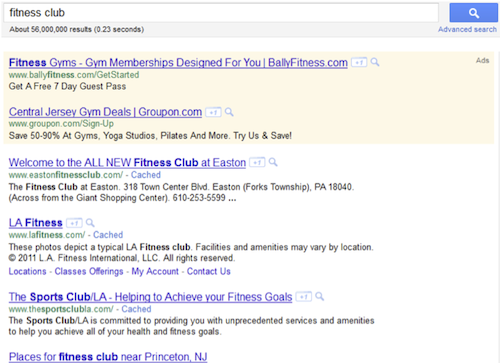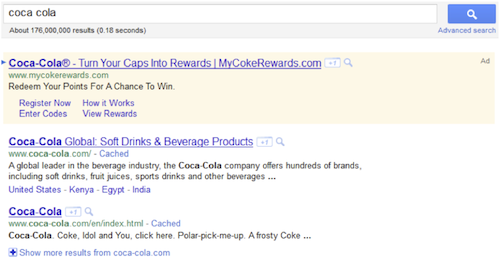A lot has changed since Google first introduced sitelinks. For one, Google has made them even bigger.
Google Sitelinks: Then & Now
In 2008 I wrote a few articles about Google then-new “sitelinks.” If a webmaster wanted their site to be blessed with sitelinks, they would need to show Google their site was useful. A year later the system had grown and webmasters were now able to refine sitelinks down to the directory level. Google’s most recent sitelink explanation/suggestions can be found at the Google Webmaster Tools Help Center.
When I read the latest sitelink introduction from Danile Rocha at the Official Google Blog, I was a bit skeptical of the last sentence: “The number of sitelinks will also vary based on your query—for example, [museum of art nyc] shows more sitelinks than [the met] because we’re more certain you want results from www.metmuseum.org.”
Some sites undeservedly received sitelinks in the past. For example, a search for “fitness club” returned LA Fitness, while searches for “health insurance” and “investment advice” yielded sites that didn’t deserve the full sitelinks, because they weren’t an actual brand. Let’s compare 2008 “fitness club” to today.
Here is 2008: (notice no paid search ads)

Now 2011 from Princeton, NJ, where I’m writing this:

And when at home in Twinsburg:

It seems LA Fitness has received a sort of “demotion” and now only has inline sitelinks. However, some would say LA Fitness is still pretty dominant – they’re still ranked first and they are the only ones above the fold that get any sort of sitelinks.
Conversely, Coca-Cola seems to have gone downhill, losing their sitelinks entirely:
2008:

2011:

Were I Coca-Cola (or Pepsi for that matter), I would prefer that U.S. searchers would be given the 2008 version rather than being asked to go to Kenya, Egypt, or India of all the places they could have picked for the inline sitelinks. In fact, I would probably be madder that I can’t get the 2011 love that Jones Soda gets:

New Sitelinks – Is Bigger Better?
Are bigger sitelinks better? Analytics will begin to answer that (Google undoubtedly already has a decent size sample), but it most depends on what the jumbo sitelinks look like.
It takes some setting up to be able to properly attribute organic traffic to sitelinks, but it can be done in each of the major measurement tools. The Jones Soda example above provides some decent sitelinks to look at from a title perspective, but three of the four “description snippets” are the same.
Based on early research, the description snippet will be between 23-29 characters including spaces. It appears to be taken primarily from the meta description tag, although Google pulls from other page content.
Jones’ mistake is having the same meta description for each of the three pages, which is simply SEO laziness. This does, however, suggest to me that the sitelink algorithm to generate description snippets isn’t as “picky” as the one used to pare down and keyword-customize the full search engine results page description.
The title is probably more important than the description, from a call-to-action perspective. In this case, each of the titles is very clear and they have been taken directly from site taxonomy. This is probably the most important thing to note as a result of these jumbo sitelinks.
We as SEOs have long desired (and sometimes succeeded) to be an equal or at least strong influence on site taxonomy. We want to incorporate keywords that are popular into the actual navigation elements of a website. Now we have yet another reason to do so, because keywords equal visits when bolded in the results, so “supersizing” certainly shouldn’t hurt.
Looking at the FBI sitelinks really shows us how seemingly random this process is, as far as we know. Perhaps enough Google toolbars have been installed on people that visit the FBI site, because how else would Google pick the following to be their sitelinks?

When you visit the FBI home page, you will find that the selection of the six “blessed” sitelinks seems to be very random. There are two pages linked-to from the top-navigation, but the rest are sub-navigation pages. Perhaps Google has matched up search volume for “Most Wanted” (and tied social data), “E-scams,” and “Spies” to help pull the content they feel will be most popular. Google is likely testing a few of the sub-navigation pages and will constantly update them based on user interaction.
By the way, the description snippet from the “What We Investigate” page is coming from the bold-tagged (not H1) headline of that page on the FBI site. They must have their meta data on an undercover mission away from most of their pages.
In short, jumbo sitelinks are another way for Google to try to give the searchers what they want. If Google finds that more people are scrolling down to results below the sitelinks, they may end up making them smaller or maybe dropping to only two rows like Jones Soda (most brands are getting three rows).
Bottom Line
It is the responsibility of webmasters to work with the marketing team to ensure youre’ making the most of sitelinks, and to use Google Webmaster Tools to request the removal of any you don’t like. Someday, maybe Google will allow us to pick our own sitelinks for brand search results, but for now the only way to pick your own is to fine tune your site’s paths to lead to the right pages.






